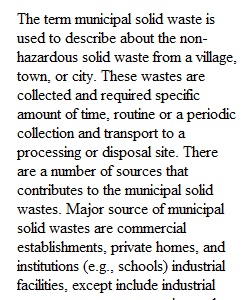


Q Discuss the sources and beneficial uses of municipal solid waste. Describe the differences between garbage, rubbish, and trash. Elaborate on the four characteristics of optimum routing of MSW collection trucks. Explain the purpose of transfer stations. Provide two positive and two negative aspects of incinerators. Describe the purpose of composting. Discuss four differences between dumps and landfills. Address the following question: If each person in a city of 20,000 people generates 5 pounds per day of MSW, how many pounds of MSW are generated in a year in the city? Address the following question: In a different city, if the landfill volume required per year is 300,000 m3, and the average fill depth is 15 m, what is the required landfill area (m2) per year?
View Related Questions